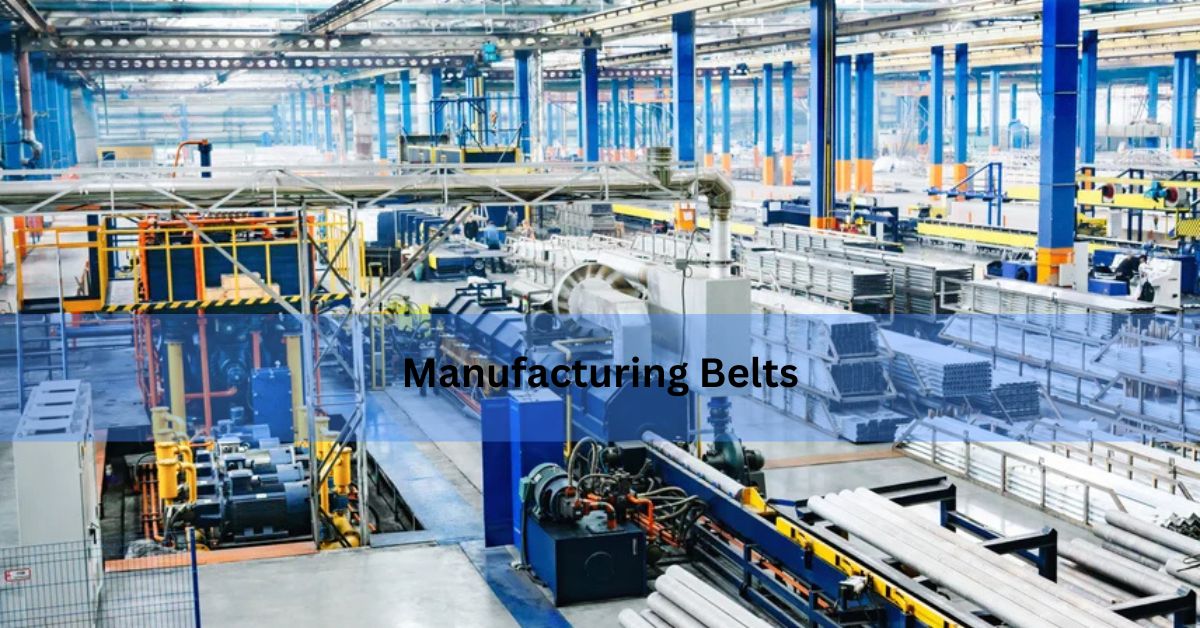Manufacturing belts play a crucial role in industrial operations by facilitating material movement and power transmission across different sectors. From conveyor belts in factories to timing belts in automobiles, these essential components ensure efficiency, automation, and reliability in various manufacturing processes. Understanding the different types, materials, and applications of manufacturing belts can help industries optimize their production lines and enhance overall productivity.
Types of Manufacturing Belts
Manufacturing belts come in different forms, each designed for specific industrial applications. The most commonly used belts include:
1. Conveyor Belts
Conveyor belts are used to transport materials from one point to another in manufacturing plants, warehouses, and distribution centers. These belts are available in various designs, such as:
- Flat Belts: Ideal for general material handling.
- Modular Belts: Made of interlocking plastic segments for easy cleaning.
- Cleated Belts: Equipped with cleats to prevent material rollback.
- Curved Belts: Designed for conveyor systems with turns and bends.
2. Timing Belts
Timing belts are essential for synchronous motion control in machinery. They operate with toothed pulleys to ensure precise movement. The main types are:
- Synchronous Belts: Provide accurate timing without slippage.
- Asynchronous Belts: Offer flexibility with variable timing options.
3. V-Belts
V-belts are commonly used in power transmission applications where high torque and efficiency are required. Types of V-belts include:
- Classical V-Belts: Standard design for moderate loads.
- Narrow V-Belts: Improved efficiency with a compact profile.
- Cogged V-Belts: Reduced heat buildup for longer lifespan.
4. Specialty Belts
Some industries require specialized belts such as:
- Variable Speed Belts: Adjustable for different speed applications.
- Ribbed Belts: Multi-grooved design for improved grip and performance.
Also Read: Henry Keele University Of Denver – A Legacy Of Academic Excellence!
Materials Used in Manufacturing Belts
The choice of materials determines the durability, flexibility, and performance of manufacturing belts. Common materials include:
| Material | Properties | Applications |
| Rubber | High flexibility and durability | Automotive, mining |
| Polyurethane | Chemical resistance and high strength | Food processing, packaging |
| PVC | Lightweight and cost-effective | Textile, logistics |
| Fabric (Cotton, Polyester, Aramid) | Reinforces strength and flexibility | Conveyor belts |
| Metal (Steel Cords, Wire Mesh) | Extreme durability for heavy loads | Mining, industrial lifting |
Manufacturing Process of Belts
The production of manufacturing belts involves several key steps:
- Design & Engineering: Determining specifications based on industry requirements.
- Material Preparation: Selecting and mixing raw materials.
- Forming & Shaping: Extrusion and calendaring techniques are used.
- Curing & Vulcanization: Enhancing the belt’s strength and elasticity.
- Finishing & Quality Control: Cutting, splicing, and inspecting for defects.
Applications of Manufacturing Belts
Manufacturing belts are indispensable across various industries:
- Automotive: Timing and drive belts ensure engine efficiency.
- Food Processing: Hygienic conveyor belts transport goods.
- Mining & Quarrying: Heavy-duty belts handle bulk materials.
- Textile Industry: Belts drive machines for fabric production.
- Packaging & Logistics: Conveyor belts streamline sorting and shipping.
How to Select the Right Manufacturing Belt
Choosing the right belt depends on several factors:
- Load Capacity: Ensure the belt can support the required weight.
- Speed Requirements: Match the belt speed to machinery needs.
- Environmental Conditions: Consider temperature, moisture, and chemicals.
- Durability & Maintenance: Opt for materials that withstand wear and tear.
- Industry Standards Compliance: Adhere to safety and quality regulations.
Maintenance and Troubleshooting Tips
To extend the lifespan of manufacturing belts, follow these maintenance tips:
- Regular Inspections: Check for wear, cracks, and misalignment.
- Proper Tensioning: Avoid excessive slack or over-tightening.
- Cleaning & Lubrication: Prevent debris buildup that can cause damage.
- Troubleshooting Issues: Address common problems like slippage, noise, and excessive wear promptly.
Also Read: IPFounder Net – Understanding Its Role in Online Privacy and Security!
Innovations and Future Trends in Manufacturing Belts
The industry is evolving with technological advancements:
- Smart Belts with Sensors: Enable real-time monitoring and predictive maintenance.
- Eco-Friendly Materials: Sustainable and biodegradable belt options.
- Automation & AI Integration: Enhancing belt efficiency in smart factories.
FAQ’s About Manufacturing Belts
What are the key differences between rubber and polyurethane belts?
Rubber belts are more flexible and shock-absorbent, while polyurethane belts offer higher chemical resistance and longevity.
How do I determine the correct belt size for my machinery?
Measure the belt’s length, width, and thickness, or refer to manufacturer guidelines.
Can conveyor belts be customized for specific applications?
Yes, conveyor belts can be designed with custom cleats, coatings, and reinforcements.
What factors contribute to premature belt failure?
Overloading, improper tensioning, lack of maintenance, and environmental factors can cause early failure.
Are there belts designed for extreme temperatures?
Yes, heat-resistant and cold-resistant belts are available for extreme conditions.
How do I know when it’s time to replace a manufacturing belt?
Signs like visible cracks, fraying edges, unusual noises, slipping, or decreased efficiency indicate it’s time to replace the belt. Regular inspections help prevent unexpected failures.
What is the difference between a conveyor belt and a power transmission belt?
A conveyor belt is used for transporting materials in industries, whereas a power transmission belt is designed to transfer mechanical power between pulleys in machinery.
Are there anti-static or flame-resistant manufacturing belts available?
Yes, certain industries, such as electronics and mining, use anti-static and flame-resistant belts to meet safety regulations and prevent hazardous situations.
How does belt tension affect performance?
Proper tension ensures optimal efficiency and longevity. Over-tensioning can cause excessive wear, while under-tensioning can lead to slippage and reduced power transmission.
Can manufacturing belts be recycled or repurposed?
Some belts, especially rubber and polyurethane ones, can be recycled into new products or repurposed for other industrial or DIY applications, contributing to sustainability efforts.
Conclusion
Manufacturing belts are essential components in industrial processes, enabling smooth operations across various sectors. Understanding the different types, materials, and applications helps in selecting the right belt for optimal performance. Regular maintenance and staying updated with innovations ensure prolonged belt life and improved efficiency. By leveraging this comprehensive guide, industries can enhance productivity and make informed decisions when choosing manufacturing belts.
Read More:




